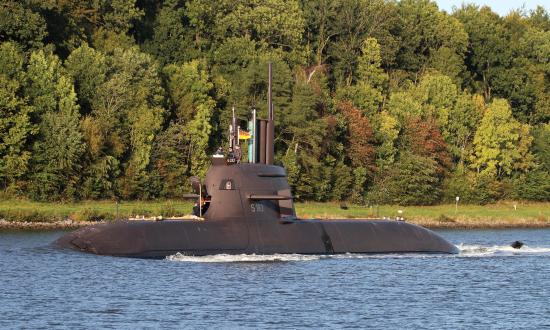The duty to follow lawful orders is the bedrock of martial discipline and the ability to achieve military objectives. For the U.S. armed forces, this duty is governed by the Uniform Code of Military Justice (UCMJ)—specifically Articles 90–92—and in this context, there generally is an assumption that orders are legal unless they explicitly contravene the Constitution or law. In testimony before Congress, former head of U.S. Strategic Command General Robert Kehler stressed the fact that members of the U.S. military have a responsibility to disobey illegal orders.1
While this legal standard seems straightforward, the intersection of the law and the realities of modern warfare can complicate matters. This is especially true in the case of nuclear weapons, the use of which has confounded strategists and scholars of the Law of Armed Conflict (LOAC) since their introduction. While all publicly available documents on U.S. nuclear strategy contend the military’s planned uses for nuclear weapons are all in compliance with the law, they make no attempt to justify this claim.2 Indeed, most conceivable uses for such weapons involve destruction of civilian life, as nuclear deterrence rests on the implicit threat of punishment to civilian populations.3 This raises important questions about the legality of nuclear use and deterrence generally, as well as the responsibility of military officers with regard to nuclear weapons.
Implicit in Article 90 of the UCMJ is the responsibility to disobey illegal orders from a superior. Were a superior to order the murder of a civilian noncombatant, for example, there would be little debate about the nature of the war crime. However, the issue is more ambiguous in the case of bombardment, and with ordnance as destructive as nuclear weapons, questions about proportionality, distinction, and military necessity become even more difficult.
There is a significant corpus of statutory and customary international law governing protections for civilians in war, though for the purposes of U.S. nuclear strategy, Protocol I Additional to the Geneva Conventions is the most important. Protocol I was never ratified by the U.S. Senate, but large portions of it are considered valid expressions of customary law by the military.4 Because of this, much of Protocol I is applicable to assessments of U.S. nuclear strategy. Article 51 is particularly important, as it outlaws the direct targeting of civilian populations or attacks that cause incidental civilian casualties disproportionate to the military advantage gained.5
However, as some scholars have pointed out, rules such as Article 51 provide only a general standard as to when the use of force becomes disproportionate or indiscriminate.6 Combined with the secretive nature of nuclear targeting and the intentional ambiguity regarding what is considered a legitimate military target, this makes it difficult to assess if and when use of nuclear weapons would comply with the laws of war. However, authors Scott Sagan and Jeffrey Lewis introduce a novel legal standard in their writing that helps in exploring the legality of the use of nuclear weapons. They argue for a “principle of necessity,” which posits that the use of nuclear weapons would be inherently disproportionate in any circumstance where a target could be eliminated by conventional means.7
The logic underlying this standard is relatively simple. For a nonnuclear example, consider the following: Insurgents have occupied a building in a crowded city quarter, and U.S. forces can eliminate the threat with either a 500-pound bomb or a massive ordnance air burst (MOAB) munition. Use of a MOAB, with the resulting higher civilian casualties, would be inherently disproportionate because the threat could be eliminated by less destructive means. Sagan and Lewis argue that this same principle underpins the use of nuclear weapons: Using nuclear weapons is not inherently illegal, but using them when a viable alternative means of warfighting exists is.8
In the event of a nuclear war, single buildings would not be the objects of military contestation. Bases, production centers, and other strategic areas would be the targets of opposing nuclear arsenals. Though the United States today claims not to target cities as it planned at the height of the Cold War, the issue of proximity to noncombatants endures. With few exceptions, most military targets are not isolated enough to prevent the mass killing of civilians during nuclear war. Former State Department attorney Newell Highsmith has argued that, in many cases of nuclear retaliation, as well as in nearly all cases of nuclear first use, the anticipated casualties among civilians would render the use of nuclear weapons illegal.9
Highsmith makes a point to excuse nuclear deterrence, since if successful it results in zero deaths and thus does not violate Article 51 or any other law in force in the United States.10 But he does not grapple with the scope for the legal use of nuclear weapons. Recent U.S. nuclear planning documents—both the 2018 Nuclear Posture Review and Nuclear Operations—claim that all war plans comply with the laws of war, but the limited circumstances in which nuclear weapons legally could be used undermines any war plan involving the use of strategic nuclear weapons in proximity to population centers.11 In addition, any conception of deterrence based on mutually assured destruction or unacceptable losses is incompatible with LOAC, even if U.S. adversaries eschew the same ethical standards to which the U.S. military adheres.
Because of this, a military officer tasked with carrying out a nuclear strike order could understand said order to be illegal. Even if there is disagreement as to whether such an order is illegal, any decision to launch nuclear weapons in anger could face a significant legal challenge. In light of this, the role of nuclear weapons in U.S. strategic planning requires reassessment.
One possible response to the issues of proportionality and discrimination is to include low-yield, tactical nuclear weapons in the U.S. arsenal. Such a move was favored by some members of the House of Representatives, though the measure was defeated during voting.12 While deployment of a smaller nuclear warhead would pose a less significant risk to civilians in proximity to a military target, the issues of discrimination in aftereffects and the strategic issue of signaling remain. Notably, the proposal to deploy such weapons on board the Ohio-class submarines could introduce dangerous ambiguity with regard to signaling U.S. intentions, as the submarine could represent a platform for strategic deterrence or for the aggressive use of tactical nuclear weapons with a lower standard for use. Despite the stated goal of countering Russia’s “escalate to de-escalate strategy,” such a move could actually risk escalation.13
Another possible option would be to constrain the scope of U.S. nuclear doctrine. This response is largely dependent on the interpretation of those engaged in the decision-making process, and it fails to extricate military officers from the problem of legal ambiguity. Even were the United States to implement clearer standards for use and reduce the arsenal to a small stockpile of strategic weapons with no forward-deployed assets, the fundamental problem of legality of use would make U.S. deterrent threats weak.14 Even if the issue were only that officers might delay a strike order to adjudicate its legality rather than disobey it outright, the threat of a timely, overwhelming response to an adversary would be undermined.
Given the legal and ethical issues involved with the use of nuclear weapons, and despite potential confrontation with amoral adversaries, the best approach to ensuring the existential safety of the United States is to pursue nuclear disarmament as a normative goal of U.S. security policy. This is not to say unilateral disarmament is a logical course of action; however, since deterrence is undermined by military officers’ responsibility to abide by LOAC, the only way to eliminate the threat of nuclear weapons is to remove them from the calculus of modern war. Such an endeavor is complicated, especially considering the potential recalcitrance of near-peer adversaries such as Russia and China or less regulated nuclear powers such as India and Pakistan.
Then again, it remains military officers’ responsibility to discharge their duties in compliance with the law. Failure to do so would undermine not only the moral legitimacy of the military and LOAC, but also jeopardize more than a century of humanitarian law intended to preserve human dignity and the safety of civilians at home and abroad during times of war.
This position is not based on a moral standard beyond the statutes that govern war, nor is it a criticism of the women and men who have dedicated their careers to planning for the worst contingencies of war. But as long as officers in the U.S. military take their obligations to the law seriously, the use of nuclear weapons is a dereliction of those laws. The responsible course of action is abolition, so these weapons, capable of destroying humanity, face extermination themselves.
1. Statement of General C. Robert Kehler, U.S. Air Force (Retired), before the Senate Foreign Relations Committee, 14 November 2017, www.foreign.senate.gov/imo/media/doc/111417_Kehler_Testimony.pdf, 5.
2. See Nuclear Operations (Joint Chiefs of Staff, 11 June 2019), https://fas.org/irp/doddir/dod/jp3_72.pdf, III-4; and Nuclear Posture Review (U.S. Department of Defense, 2018), https://media.defense.gov/2018/Feb/02/2001872886/-1/-1/1/2018-NUCLEAR-POSTURE-REVIEW-FINAL-REPORT.PDF, 23.
3. Jeffrey Lewis and Scott Sagan, “The Nuclear Necessity Principle: Making U.S. Targeting Policy Conform with Ethics & the Laws of War,” Daedalus 145, no. 4 (Fall 2016): 63.
4. Michael Matheson, “Additional Protocol I as an Expression of Customary International Law,” 9 May 1986, www.loc.gov/rr/frd/Military_Law/pdf/LOAC-Documentary-Supp-2015_Ch26.pdf.
5. Article 51: “Protection of the Civilian Population,” Protocol Additional to the Geneva Conventions of 12 August 1949, and relating to the Protection of Victims of International Armed Conflicts (Protocol I), 8 June 1977, https://ihl-databases.icrc.org/ihl/WebART/470-750065.
6. Lewis and Sagan, “The Nuclear Necessity Principle,” 63.
7. Lewis and Sagan, 64.
8. “Treaty on the Prohibition of Nuclear Weapons,” Agenda Item 9, U.N. Conference to Negotiate a Legally Binding Instrument to Prohibit Nuclear Weapons, Leading Towards Their Total Elimination, 27–31 March and 15 June–7 July 2017, New York, https://undocs.org/A/CONF.229/2017/8.
9. Newell L. Highsmith, “On the Legality of Nuclear Deterrence,” Livermore Papers on Global Security No. 6 (April 2019), 80.
10. Highsmith, “On the Legality of Nuclear Deterrence,” 80.
11. Nuclear Posture Review, 23, and Nuclear Operations, III-4.
12. Ellen Mitchell, “House Panel Shoots Down Funding, Deployment of Low-Yield Nukes in Defense Bill,” The Hill, 12 June 2019.
13. Olga Oliker and Andrey Balitskiy, “The Nuclear Posture Review and Russian ‘De-escalation’: A Dangerous Solution to a Nonexistent Problem,” War on the Rocks, 20 February 2018.
14. Highsmith, “On the Legality of Nuclear Deterrence,” 81.






